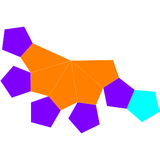- Gyroelongated pentagonal pyramid
-
Gyroelongated pentagonal pyramid 
Type Johnson
J10 - J11 - J12Faces 3x5 triangles
1 pentagonEdges 25 Vertices 11 Vertex configuration 5(33.5)
1+5(35)Symmetry group C5v Dual polyhedron - Properties convex Net 
In geometry, the gyroelongated pentagonal pyramid is one of the Johnson solids (J11). As its name suggests, it is formed by taking a pentagonal pyramid and "gyroelongating" it, which in this case involves joining a pentagonal antiprism to its base.
It can also be seen as a diminished icosahedron, an icosahedron with the top (a pentagonal pyramid, J2) chopped off by a plane. Other Johnson solids can be formed by cutting off multiple pentagonal pyramids from an icosahedron: the pentagonal antiprism and metabidiminished icosahedron (two pyramids removed), and the tridiminished icosahedron (three pyramids removed).
The 92 Johnson solids were named and described by Norman Johnson in 1966.
Dual polyhedron
The dual of the gyroelongated pentagonal pyramid has 11 faces: 5 kites, 1 regular pentagonal and 5 irregular pentagons.
Dual gyroelongated pentagonal pyramid Net of dual 

External links

This polyhedron-related article is a stub. You can help Wikipedia by expanding it.
